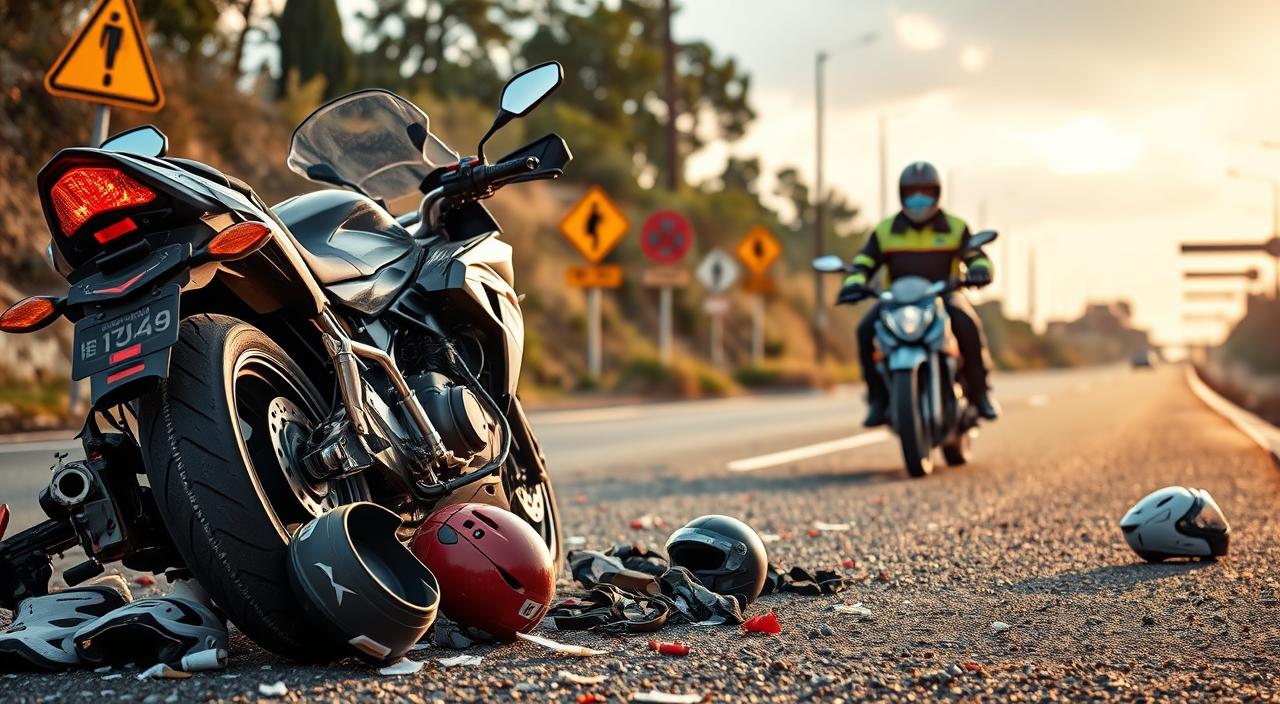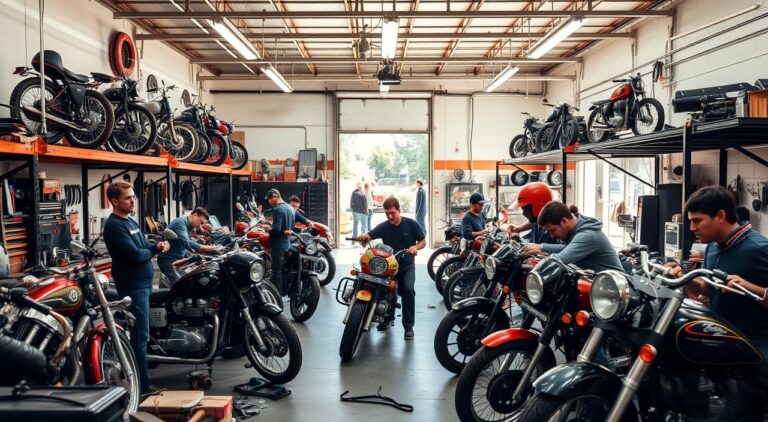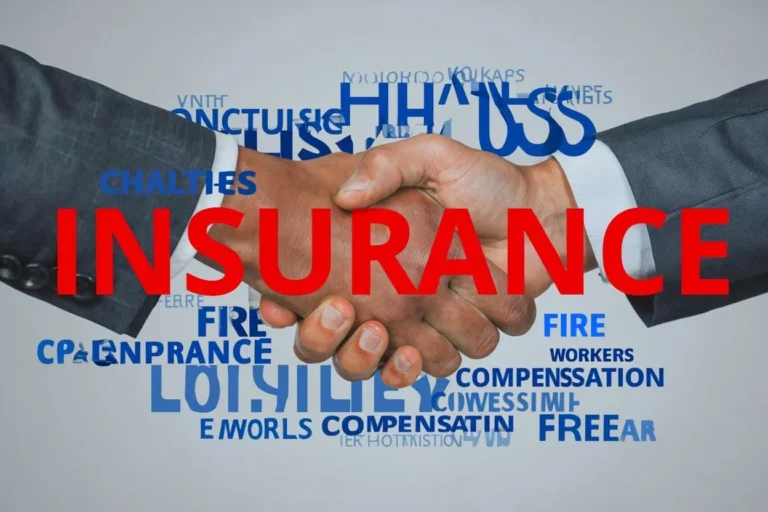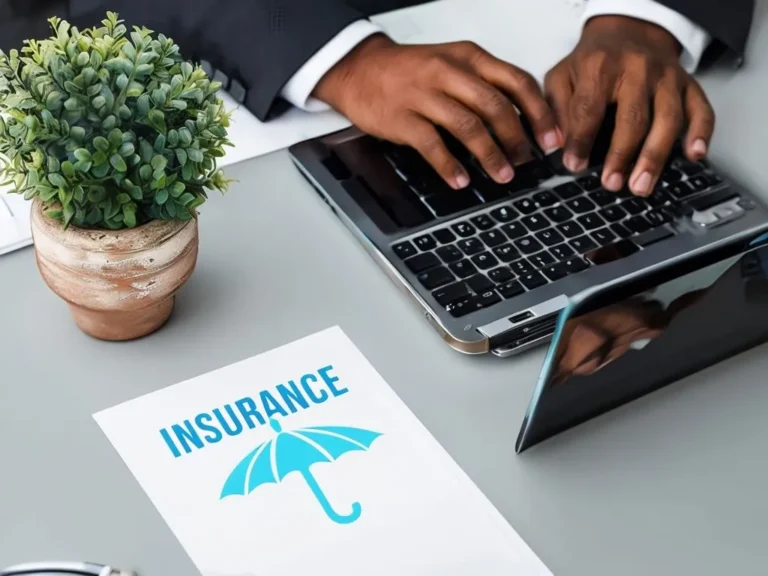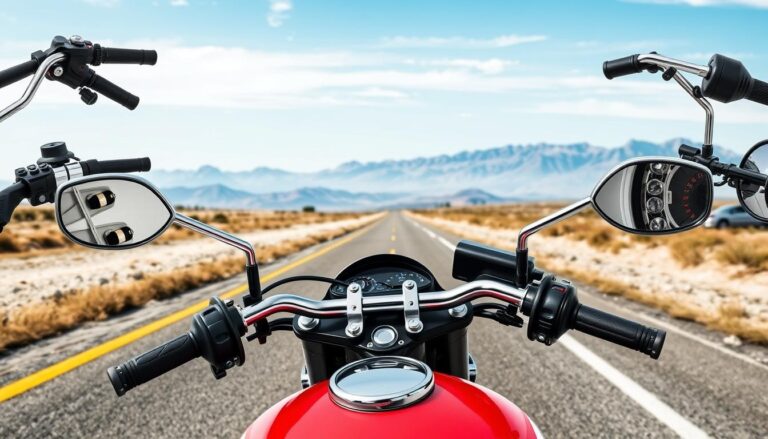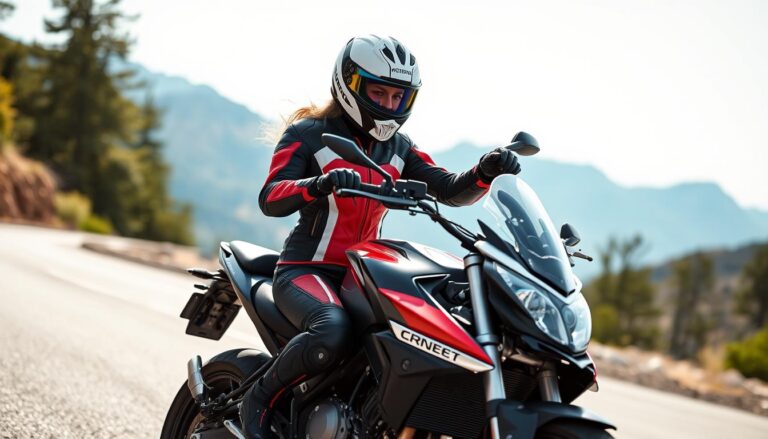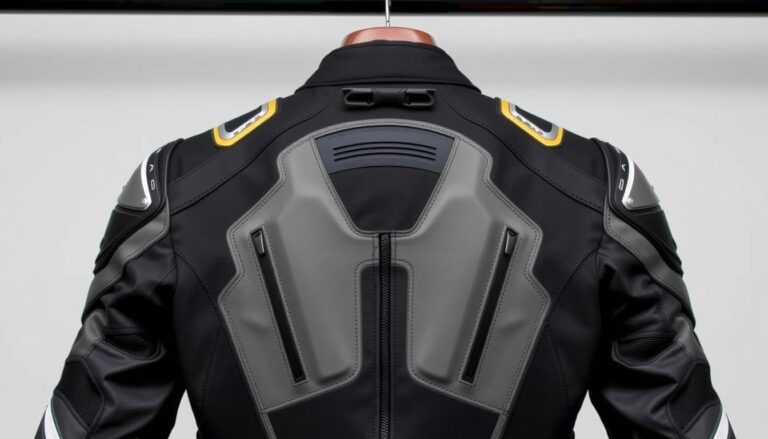Imagine the freedom of cruising down an open road, the wind in your hair, and the thrill of adventure at your fingertips. Riding a motorcycle can be a breathtaking experience. But, it comes with significant risks. Each year, countless motorcycle accidents remind us of the fragility of life.
Understanding what leads to these motorcycle crashes isn’t just about statistics. It’s about making informed choices that can help protect you and your loved ones. Knowledge of motorcycle accident prevention can be your first step toward safer riding. As you navigate the complexities of motorcycling, understanding potential hazards and preparing for them is key—because every ride should be about enjoyment, not regret.
Table of Contents
Understanding the Common Causes of Motorcycle Accidents
Knowing why motorcycle accidents happen is key for riders to stay safe. By understanding these reasons, riders can avoid dangerous situations. Many accidents are caused by things like distracted riding, speeding, and poor road conditions.
Distracted Riding
Many riders don’t realize how dangerous it is to be distracted while riding. Texting, using a GPS, or talking to passengers can take your eyes off the road. These distractions can lead to crashes, which is why staying alert is so important.
Speeding and Reckless Behavior
Speeding and reckless riding are big risks for motorcyclists. Actions like speeding, weaving through traffic, or making sudden lane changes can be deadly. Speeding is a major cause of accidents, leaving riders at risk of serious injury or death.
Poor Road Conditions
Poor road conditions are another common cause of motorcycle accidents. Potholes, debris, and bad signs can be very dangerous. It’s especially important to be careful when riding in new areas. Always be ready to adjust your ride based on the road’s condition.
The Impact of Weather on Motorcycle Safety
Weather can greatly affect motorcycle safety. Riders face many challenges in bad weather, which can lead to crashes. Knowing these challenges helps in preventing accidents and improves how you ride.
Rain and Wet Roads
Rain makes roads slippery, making it harder to stop. It’s crucial to ride slowly and keep a safe distance from cars. When you need to stop or speed up, do it gently to avoid losing control.
Fog and Reduced Visibility
Fog makes it hard to see, making it tough to spot cars and obstacles. To stay safe, slow down and be more aware of your surroundings. Using lights, wearing bright clothes, and reflective gear can help others see you better.
Extreme Temperatures
Hot and cold weather can affect how comfortable you are and how well your bike works. In the heat, drinking water is key to avoid getting tired and crashing. In the cold, wearing layers helps keep you warm, and make sure your bike is ready for the cold, as it can affect how it runs.
| Weather Condition | Risks Involved | Precautionary Measures |
|---|---|---|
| Rain | Reduced traction, longer stopping distances | Decrease speed, maintain safe distance |
| Fog | Poor visibility, higher collision risk | Use lights, wear bright colors |
| Extreme Heat | Fatigue, dehydration | Stay hydrated, take breaks |
| Extreme Cold | Discomfort, equipment malfunctions | Dress in layers, check motorcycle maintenance |
The Role of Motorcycles in Traffic Accidents
Motorcycles are often involved in traffic accidents, showing how vulnerable riders are compared to car drivers. Knowing the statistics and common accident scenarios can help make riding safer. It’s important for every motorcyclist to understand these trends.
Statistics on Motorcycle Accidents in the U.S.
Recent data shows motorcyclists face higher risks on the roads. They are 28 times more likely to die in an accident than car passengers. Here are some key statistics:
- Over 5,000 motorcyclists died in crashes in the U.S. in a recent year.
- About 80% of motorcycle accidents result in injury or death.
- Younger riders, aged 18-24, are often involved in accidents.
Common Scenarios Leading to Accidents
Knowing common accident scenarios can help keep you safe. The most common include:
- Left-turn collisions, where vehicles don’t see the motorcycle.
- Being rear-ended at stoplights, often due to distracted driving.
- Blind spots, where other vehicles fail to detect the motorcycle.
Being aware of these scenarios can help you stay alert and make safer choices. If you’re ever in an accident, a motorcycle accident attorney can help with legal issues.
Protective Gear: Your First Line of Defense
Protective gear is key to keeping you safe while riding. The right equipment can lessen injury severity in motorcycle accidents. It’s vital to invest in helmets, clothing, and more for every rider.
The Importance of Helmets
Helmets are crucial for head protection, cutting injury risk by up to 37%. Make sure your helmet fits well and meets safety standards. Wearing a helmet regularly can greatly reduce accident risks.
Choosing the Right Protective Clothing
Your riding clothes are important too. Look for jackets with padding, tough pants, and boots made for riding. This gear helps prevent cuts and breaks in case of an accident. It’s all about staying safe and reducing injury risks.
Footwear and Gloves
Good shoes and gloves are essential for grip and protection. Riding shoes offer stability, while gloves improve control. Wearing the right gear keeps you safe and confident on the road.
How to Improve Your Riding Skills
Improving your riding skills is key for safety and fun on the road. There are many ways to boost your skills and ride with confidence. This can help prevent accidents and make your rides better.
Taking Motorcycle Safety Courses
Motorcycle safety courses are a great investment. They teach you how to ride safely and avoid accidents. Learning these skills can reduce your chances of being in an accident.
Practicing Defensive Riding Techniques
Defensive riding helps you stay safe by watching out for dangers. Important steps include:
- Maintaining a safe following distance.
- Being aware of other drivers’ actions.
- Adjusting your speed according to road conditions.
Using these techniques makes your rides safer and helps prevent accidents.
Staying Sober and Alert
It’s important to stay sober and alert while riding. Alcohol or drugs can lead to accidents. Make sure you’re focused and ready before you ride to stay safe.
Understanding Vehicle Blind Spots
Knowing your blind spots is key to staying safe on a motorcycle. It helps you dodge dangers on the road. It’s especially important to be aware of your position around bigger vehicles. This is because many crashes happen when drivers don’t see motorcyclists.
Recognizing Your Blind Spots
Get to know the spots around your bike that block your view. Blind spots differ based on the vehicle behind you. Here are some important points to remember:
- The area directly behind your motorcycle
- The space to the sides of your motorcycle
- The space directly in front of larger vehicles
How to Avoid Other Vehicles’ Blind Spots
It’s vital to position your bike to avoid being missed by others. Here are some tips:
- Stay visible by riding in designated lanes.
- Avoid riding in the blind spots of larger vehicles.
- Use mirrors to monitor nearby traffic.
- Signal your intentions clearly to alert other drivers.
Being aware and positioning your bike right can make riding safer. Knowing these tips can help you avoid accidents and enjoy safer rides.
| Vehicle Type | Common Blind Spots | RecommendedActions |
|---|---|---|
| Cars | Sides and rear | Maintain distance, and use your mirrors |
| Trucks | Front, sides, and rear | Do not linger in blind spots |
| Buses | Front and rear | Keep a safe distance |
By using these tips, you can reduce your risk of being in a motorcycle accident. Being aware and riding smart are crucial for your safety on the road.
Legal Implications After an Accident
After a motorcycle accident, knowing your legal rights is key. Figuring out who was at fault is crucial. This includes looking at negligence, traffic law breaks, and what witnesses say.
Understanding Fault and Liability
Fault in motorcycle accidents often comes down to what people did wrong. If someone was careless, you might get compensation. Important things to think about are:
- Driver behavior leading to the accident
- Adherence to traffic laws
- Condition of the road and visibility
Filing a Claim with Your Insurance
After finding fault, you need to file a claim with your insurance. This step requires:
- Thorough documentation of the accident, including photographs and witness statements
- Details of any injuries sustained and damage to your motorcycle
- Submission of medical records to support your claim
The Role of Motorcycle Accident Lawyers
Hiring a motorcycle accident lawyer can really help your case. They know how to handle these complex lawsuits. Their main tasks are:
- Assessing the merits of your case
- Negotiating with insurance companies for fair compensation
- Representing you in court if necessary
By understanding these legal steps, you can protect your rights. This helps you fight for fair compensation after an accident.
How to Stay Alert on the Road
Staying alert while riding a motorcycle is key to your safety. It helps prevent accidents. You can use several strategies to fight fatigue and catch drowsiness early.
Strategies for Reducing Fatigue
- Take regular breaks during long rides to stretch your legs and refresh your mind.
- Ensure you get adequate sleep the night before hitting the road.
- Stay hydrated and eat light snacks to maintain your energy levels.
Recognizing Signs of Drowsiness
Knowing your body’s signals is crucial. Signs like yawning, trouble focusing, or veering off course mean you’re tired. Catching these signs early helps keep you alert and safe.
Being alert not only keeps you safe but also affects compensation if an accident happens. Fighting fatigue is essential for a safer ride.
What to Do If You Are in an Accident
Motorcycle accidents can be very scary and upsetting. Knowing how to act right away can help a lot. It’s important for your safety and rights.
Immediate Steps to Take After an Accident
First, check if you’re hurt. Even if you don’t feel anything, you might have injuries. If you need to, get medical help right away.
If it’s safe, move your bike to the side of the road. This helps avoid more accidents.
Gathering Important Information
Getting the right info is key for your case. Swap details with others, like names and insurance info. Also, get statements from witnesses.
Take photos of the scene. Show the damage, where things are, and the road. This helps a lot, especially when you talk to a lawyer.
Seeking Medical Attention
Your health is most important. See a doctor, even for small symptoms. Some injuries take time to show up.
Keep records of all your doctor visits and treatments. This is crucial for insurance and legal actions. If you need ongoing care, keep detailed records for your lawyer.
Community Resources for Motorcycle Safety
Getting involved with community resources can really help you learn about preventing motorcycle accidents. These resources give you important info and help you feel part of a community. Joining local riding clubs and organizations can teach you a lot about safe riding.
Many clubs have group rides, safety seminars, and talks. These focus on real-life experiences with motorcycle accidents. They help you get ready for a safer ride.
Local Riding Clubs and Organizations
Local riding clubs and organizations are perfect for building a community and sharing knowledge. They often have meetings and events. At these, you can learn about road safety, maintenance, and accident prevention.
Going to these gatherings lets you learn from experienced riders. They share their knowledge of road challenges.
Online Resources and Forums
The internet has lots of info on motorcycle safety through forums and websites. These places let you talk to other riders, ask questions, and share your experiences. Talking with others can help you understand more and stay up-to-date on safety rules.
Safety Workshops and Events
Going to safety workshops is a great way to improve your riding skills. Many groups, like motorcycle safety foundations, run these workshops. They teach you about motorcycle handling and how to avoid accidents.
Attending these events can give you practical skills. These skills help you stay safe while riding.
FAQ
What are the common causes of motorcycle accidents?
Common causes include distracted riding, speeding, and poor road conditions. These factors are big contributors to motorcycle crashes, according to statistics.
How can I prevent motorcycle accidents?
To avoid accidents, ride safely, keep your bike in good shape, and wear protective gear. Stay alert and take motorcycle safety courses to improve your skills.
What should I do if I get in a motorcycle accident?
First, check for injuries and get medical help if needed. Then, collect insurance details and witness statements. A motorcycle injury lawyer can help with the claims process.
Can I claim compensation after a motorcycle accident?
Yes, you might be able to claim compensation for damages and injuries. Start by filing a claim with your insurance. A lawyer can guide you through this.
What role does weather play in motorcycle accidents?
Weather like rain and fog can make riding dangerous by reducing traction and visibility. Knowing how weather affects riding can help prevent accidents.
How does protective gear reduce the risk of injury in motorcycle crashes?
Protective gear, especially helmets, can greatly reduce injury risk. Helmets can cut head injury risk by up to 37%, making them crucial for riders.
What are blind spots, and how do they affect motorcycle safety?
Blind spots are areas drivers can’t see. Knowing your own blind spots and how to avoid others’ can prevent dangerous situations on the road.
How can a motorcycle accident attorney help me?
A motorcycle accident attorney can help with your lawsuit. They’ll gather evidence and fight for your rights to ensure you get fair compensation.
What are the statistics on motorcycle accidents in the U.S.?
Motorcyclists are 28 times more likely to die in a crash than car drivers. Knowing these statistics can encourage safer riding practices.
